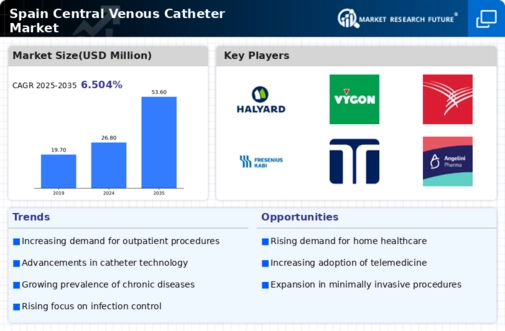Rising Healthcare Expenditure
The increase in healthcare expenditure in Spain is a significant driver for the central venous-catheter market. With the government and private sectors investing more in healthcare infrastructure, the availability of advanced medical devices is improving. In 2025, healthcare spending in Spain is expected to reach €200 billion, reflecting a growth rate of approximately 4% annually. This financial commitment allows hospitals to procure high-quality central venous catheters, which are essential for various medical procedures. Additionally, the emphasis on improving healthcare services and patient care is likely to lead to a higher demand for these devices. As a result, the central venous-catheter market is poised for growth, supported by increased funding and a focus on enhancing healthcare delivery.
Advancements in Medical Technology
Technological innovations in the medical field are significantly influencing the central venous-catheter market. The introduction of advanced materials and designs, such as antimicrobial catheters and ultrasound-guided placement techniques, enhances patient safety and reduces complications. In Spain, the adoption of these technologies is on the rise, with hospitals increasingly investing in state-of-the-art equipment. Reports indicate that the market for medical devices in Spain is projected to grow at a CAGR of 5% over the next five years, with central venous catheters being a key segment. These advancements not only improve the efficacy of treatments but also streamline procedures, making them more efficient. Consequently, the central venous-catheter market is likely to benefit from these technological enhancements, as healthcare providers prioritize patient outcomes and operational efficiency.
Expansion of Healthcare Facilities
The expansion of healthcare facilities across Spain is a crucial driver for the central venous-catheter market. As new hospitals and clinics are established, the demand for medical devices, including central venous catheters, is expected to increase. The Spanish government has initiated several healthcare projects aimed at improving access to medical services, particularly in rural areas. This expansion is projected to enhance the overall healthcare infrastructure, leading to a higher utilization of central venous catheters in various medical procedures. Furthermore, the establishment of specialized treatment centers for chronic diseases will likely contribute to the growth of the market. As a result, the central venous-catheter market is anticipated to benefit from the ongoing development of healthcare facilities, which will facilitate better patient care and treatment options.
Growing Awareness of Infection Control
The heightened awareness surrounding infection control in healthcare settings is driving the central venous-catheter market. In Spain, healthcare professionals are increasingly prioritizing the use of catheters that minimize the risk of infections, such as central line-associated bloodstream infections (CLABSIs). This focus on patient safety has led to the adoption of advanced catheter technologies, which are designed to reduce infection rates. Studies suggest that implementing strict infection control protocols can decrease CLABSI rates by up to 50%. As hospitals and clinics strive to improve patient outcomes, the demand for innovative central venous catheters is likely to rise. Consequently, the central venous-catheter market is expected to expand as healthcare providers invest in safer, more effective solutions for intravenous therapy.
Increasing Prevalence of Chronic Diseases
The rising incidence of chronic diseases in Spain is a pivotal driver for the central venous-catheter market. Conditions such as cancer, diabetes, and cardiovascular diseases necessitate long-term intravenous therapy, thereby increasing the demand for central venous catheters. According to recent health statistics, approximately 30% of the Spanish population is affected by chronic illnesses, which often require specialized medical interventions. This trend is likely to propel the market forward, as healthcare providers seek efficient solutions for patient management. Furthermore, the aging population, which is projected to reach 25% by 2030, will further amplify the need for these medical devices. As a result, the central venous-catheter market is expected to experience substantial growth, driven by the need for effective treatment options for chronic conditions.





















Leave a Comment